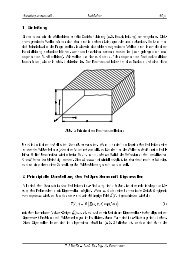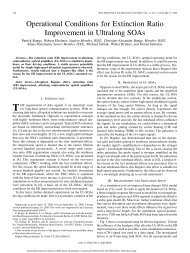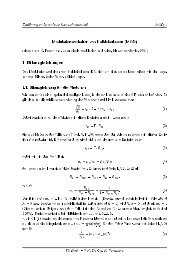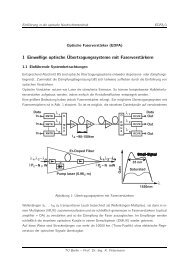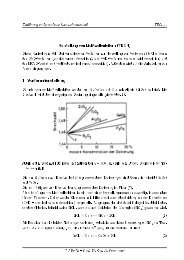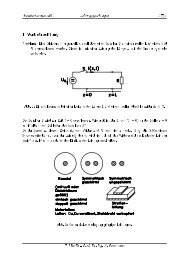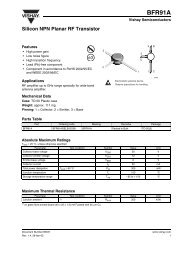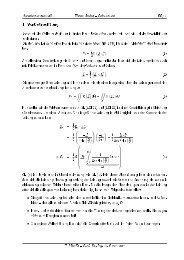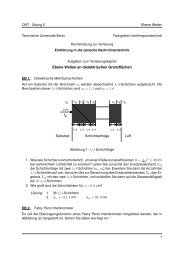Spectral characteristics of semiconductor lasers (SPEK)
Spectral characteristics of semiconductor lasers (SPEK)
Spectral characteristics of semiconductor lasers (SPEK)
Create successful ePaper yourself
Turn your PDF publications into a flip-book with our unique Google optimized e-Paper software.
Chapter 13<br />
<strong>Spectral</strong> <strong>characteristics</strong> <strong>of</strong> <strong>semiconductor</strong><br />
<strong>lasers</strong> (<strong>SPEK</strong>)<br />
In this chapter we discuss the spectral <strong>characteristics</strong> <strong>of</strong> <strong>semiconductor</strong> <strong>lasers</strong>.<br />
The spectra <strong>of</strong> index- and gain-guided <strong>lasers</strong> (compare with chapter HL-STRUK) might be different under<br />
certain circumstances, as shown in Fig. 13.1.<br />
Figure 13.1: (a) index-guided laser, (b) gain-guided laser<br />
If spontaneous emission is neglected, the gain g <strong>of</strong> the laser is given, according to chapter HL, as:<br />
g = α s − 1<br />
2L · ln(R 1 · R 2 ) (13.1)<br />
In general, the gain g depends on the wavelength (see Fig. 13.2).<br />
Below the threshold, g increases with an increasing charge carrier density, until, for a given wavelength<br />
λ = λ m , the oscillation build-up condition is achieved.<br />
If spontaneous emission is neglected, only one laser mode (λ m ) resonates at the laser threshold.<br />
Above threshold, the gain remains constant g = g s at the wavelength λ m , i.e. the gain saturates at g = g s .<br />
Two possibilities follow:<br />
1
C<br />
! <br />
<br />
<br />
<br />
<br />
<br />
<br />
<br />
<br />
C <br />
<br />
<br />
<br />
Introduction to fiber optic communications ONT/ 2<br />
D C A A 5 J J E C K C<br />
E D C A A 5 J J E C K C<br />
C I<br />
!<br />
Figure 13.2: The gain g over the wavlength λ, λ m±i - Resonance wavelength <strong>of</strong> the laser cavity, curve 1:<br />
homogeneous saturation, curve 2: inhomogeneous saturation<br />
1. Homogeneous saturation <strong>of</strong> the gain, i.e. the gain g(λ) persits even above the threshold, hence for<br />
only one wavelength λ m the gain g = g s is achieved (curve 1 in Fig. 13.2).<br />
2. Inhomogeneous saturation, i.e. the gain g(λ) increases with increasing injection and is forced to<br />
g = g s at the emission wavelength. This is known as spectral hole-burning (curve 2 in Fig. 13.2).<br />
Homogeneous saturation dominates in a <strong>semiconductor</strong> laser, since equilibrium within the conduction and<br />
valence band is achieved very fast (time constant ∼ 10 −13 s). For this reason, the spectrum is examined,<br />
assuming a homogeneous line broadening with consideration <strong>of</strong> the spontaneous emission. The starting<br />
point is the Equation<br />
dS<br />
dt = r st · S − S<br />
τ ph<br />
+ r sp · K (13.2)<br />
from chapter MOD. K (with K ≥ 1 ) is an additional correction factor for the spontaneous emission in<br />
gain-guided <strong>lasers</strong>. Assuming steady state condition ( d dt = 0 ) the number <strong>of</strong> photons S(λ µ) within a laser<br />
oscillation at the emission wavelength λ µ :<br />
Using the normalized gain coefficient<br />
r st · S(λ µ ) − S(λ µ)<br />
τ ph<br />
+ r sp · K = 0. (13.3)<br />
G(λ) = r st · τ ph = g g s<br />
(13.4)<br />
and n sp = r sp /r st , Eq. 13.3 is solved to:<br />
S(λ µ ) = n sp · K ·<br />
1<br />
1 − G(λ µ )<br />
The normalized gain G(λ µ ) coefficient can be approximated by a parabolic curve (see Fig. 13.3):<br />
(<br />
) )<br />
G(λ µ ) = G 0<br />
(1 − 2 · λµ − λ 2<br />
m<br />
∆Λ<br />
(13.5)<br />
(13.6)
Introduction to fiber optic communications ONT/ 3<br />
/ <br />
/<br />
<br />
, <br />
<br />
Figure 13.3: The parabolic approximation <strong>of</strong> the normalized gain G(λ)<br />
with G 0 = G(λ m ) . Since 1 − G 0 ≪ 1 applies, Eq. 13.6 can be written as:<br />
(<br />
)<br />
G(λ µ ) ≈ G 0 − 2 · λµ − λ 2<br />
m<br />
(13.7)<br />
∆Λ<br />
Therefore the photon number S(λ µ ) is given in the form:<br />
S(λ µ ) ≈<br />
n sp · K<br />
( )<br />
1 − G 0 + 2 · λµ−λ 2<br />
(13.8)<br />
m<br />
∆Λ<br />
and, respectively, the emitted power is (compare with chapter MOD)<br />
P (λ µ ) = K · n sp · h · ν · c (<br />
N −<br />
1<br />
2L ln(R 1R 2 ) )<br />
( )<br />
1 − G 0 + 2 · λµ−λ 2<br />
(13.9)<br />
m<br />
∆Λ<br />
The full width at half maximum (FWHM) δλ <strong>of</strong> the spectrum can be determined using Eq. (13.9) as:<br />
δλ = ∆Λ √ 1 − G 0 (13.10)<br />
The full width at half maximum δλ can be expressed as a function <strong>of</strong> the total emitted power P as:<br />
P = ∑ µ<br />
P (λ µ ) (13.11)<br />
and the mode distance (resonance distance) (see chapter HL) as:<br />
Assuming δλ ≫ ∆λ in Eq. (13.9), one obtains:<br />
δλ = c · π · h · ν<br />
2P<br />
∆λ =<br />
· ln<br />
λ2<br />
2N · L . (13.12)<br />
( 1<br />
R 1 R 2<br />
)<br />
n sp · K<br />
( ) ∆Λ 2<br />
(13.13)<br />
λ
Introduction to fiber optic communications ONT/ 4<br />
2 <br />
<br />
<br />
@ <br />
, <br />
!<br />
<br />
<br />
!<br />
Figure 13.4: Lorentzian-shaped spectrum<br />
Example: R 1 = R 2 = 0.32 , n sp = 2.5 , ∆Λ = 30 nm , λ = 850 nm and the power per mirror <strong>of</strong><br />
P<br />
2<br />
= 5 mW . Applying these values a FWHM <strong>of</strong> the spectrum can be determined to δλ = K · 0.08 nm.<br />
The FWHM can be determined for a gain-guided laser with assuming K = 20 to δλ = 1.6 nm .<br />
In an index-guided laser ( K = 1 ) the FWHM is smaller than the distance between the resonance wavelengths<br />
( δλ < ∆λ ), resulting in a single-mode emission. Hence, the different characteristic in Fig. 13.1 is<br />
explained.<br />
Although for an index-guided laser ( K = 1 ), due to Fig. 13.1, a single-mode operation for Fabry-Perot-<br />
Laser is possible, the single-mode emission is not very stable. The emission may be strongly affected by<br />
external reflections or by modulation <strong>of</strong> the laser (e.g. mode hopping or dynamic multi-mode emission).<br />
A stable single-mode emission can be achieved, if the reflectors R 1 and R 2 are designed in a wavelength-<br />
= J E L A 5 ? D E ? D J<br />
* H = C C 4 A B A J H * H = C C 4 A B A J H<br />
@ = J<br />
Figure 13.5: Schematic <strong>of</strong> a DBR-Laser (After: S. Hansmann, Laserdioden, in: E. Voges, K. Petermann,<br />
Optische Kommunikationstechnik, Springer 2002)<br />
selectively (R 1 (λ), R 2 (λ)). This results in an oscillation builds-up at which the reflection is at its maximum.<br />
Wavelength-selective reflectors can be realized using grating structures (Bragg reflectors). Fig. 13.5 shows
M<br />
<br />
N<br />
<br />
Introduction to fiber optic communications ONT/ 5<br />
a ”distributed-Bragg-reflector” (DBR)-Laser schematically, where the wavelength selection is achieved by<br />
using Bragg reflector mirrors. More customary are ”distributed feedback” (DFB)-Lasers (Fig. 13.6), in<br />
which the grating structure is extended over the entire length active layer.<br />
1 N <br />
<br />
/ C<br />
@ = J<br />
/ = J<br />
Figure 13.6: Schematic <strong>of</strong> a DFB-Laser (After: S. Hansmann, Laserdioden, in: E. Voges, K. Petermann,<br />
Optische Kommunikationstechnik, Springer 2002)<br />
For a monochromatic laser, the width <strong>of</strong> a single spectral line is also <strong>of</strong> interest. Due to the shot noise<br />
characteristic <strong>of</strong> the spontaneous emission, a single spectral line is not monochromatic, but has a finite<br />
spectral width ∆ν (Fig. 13.7).<br />
In order to estimate intuitively the linewidth ∆ν, Eq. (13.3) is considered K = 1 (index-guided). Assuming<br />
stationary equilibrium ( d dt<br />
= 0 ), this results in:<br />
(<br />
S · r st − 1 )<br />
τ ph<br />
} {{ }<br />
− 1<br />
τ eff<br />
+ n sp<br />
= dS<br />
τ ph dt<br />
!<br />
= 0, (13.14)<br />
where r sp ≈ n sp /τ ph , and denotes the spontaneous emission (attached with shot noise), to which the photon<br />
number S in the laser cavity reacts with the time constant τ eff .<br />
A first intuitive trial solution for the linewidth ∆ν leads to<br />
∆ν = 1 2 ·<br />
1<br />
2π · τ eff<br />
. (13.15)<br />
Spontaneous emission leads to both amplitude and phase fluctuations. The amplitude fluctuations are suppressed<br />
due to the interaction between the photons (described by their balance equation (1) in chapter MOD)<br />
and the electrons (described by the balance equation Eq. (13) in chapter MOD). For this reason a factor<br />
( 1/2 ) was introduced in Eq. (13.15). By using Eq. (13.14), the effective lifetime τ eff can be described as:<br />
τ eff = S · τ ph<br />
n sp<br />
, (13.16)<br />
so that Eq. (13.15) can be written as:<br />
∆ν =<br />
n sp<br />
4π · τ ph · S<br />
(13.17)
,<br />
K<br />
<br />
<br />
Introduction to fiber optic communications ONT/ 6<br />
K ?<br />
Figure 13.7: Linewidth ∆ν <strong>of</strong> a single-mode laser<br />
Eq. (13.17) already provides the Schawlow-Townes-Relation (also known as Schawlow-Townes limit) for<br />
the linewidth.<br />
In fact, the fluctuation <strong>of</strong> the photon number is associated with the fluctuation <strong>of</strong> the charge carrier density<br />
n and therefore also, due to the relation α ch = dn′ /dn<br />
dn ′′ /dn , with the fluctuations <strong>of</strong> the real n′ and imaginary<br />
part n ′′ <strong>of</strong> the refractive index.<br />
This relation leads to fluctuations <strong>of</strong> the laser resonance wavelength and results thus in a broader linewidth<br />
∆ν =<br />
n sp<br />
4π · τ ph · S · (1<br />
+ αch<br />
2 )<br />
(13.18)<br />
Example: By using the values S = 2·10 5 (compare to the example on page MOD/2), τ ph = 2 ps , n sp = 2<br />
and α ch = 5 a linewidth <strong>of</strong> ∆ν = 10 MHz is obtained, which is a typical value for a <strong>semiconductor</strong> laser.<br />
It is customary to indicate the coherence time <strong>of</strong> a laser:<br />
τ c =<br />
1<br />
2π · ∆ν<br />
(13.19)<br />
or the coherence length<br />
L c = c · τ c (13.20)<br />
A coherence length <strong>of</strong> approximately L c = 5 m results from the data above.



